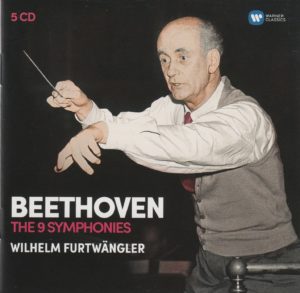 This morning’s conductor is the legendary Wilhelm Furtwangler (1886-1954). The orchestra is the Wiener Philharmoniker (Vienna Philharmonic). The venue is the Royal Albert Hall in London.
This morning’s conductor is the legendary Wilhelm Furtwangler (1886-1954). The orchestra is the Wiener Philharmoniker (Vienna Philharmonic). The venue is the Royal Albert Hall in London.
Maestro Furtwangler died two years after this recording was made.
I first encountered Wilhelm Furtwangler during my Bruckner projects. Something about him – maybe I just like saying his name – intrigued me. So I chose him for my Beethoven project.
 Recordings from his era (66 years ago!) are typically flat sounding and in Mono, not stereo. And this one is no exception. But the historicity of these performances makes the recordings not only highly listenable, but fascinating as well.
Recordings from his era (66 years ago!) are typically flat sounding and in Mono, not stereo. And this one is no exception. But the historicity of these performances makes the recordings not only highly listenable, but fascinating as well.
At this moment, I’m listening to a piece of history – a recording made going on 70 years of age, from a conductor of great fame, in a world-renowned venue, with musicians at the top of their game. And I’m listening to it! I consider myself fortunate, indeed.
From the essay titled “Furtwangler Conducts Beethoven” (written by Richard Osborne) in the liner notes:
From Furtwangler’s earliest years, Beethoven was the lodestar of his art and ambition. Privately educated, mainly by colleagues of his father at Munich University, he is said to have known all Beethoven by the age of 12, much of it by heart.
Why Beethoven? Furtwangler explained that Beethoven conveyed to him more vividly than any other artist the “organic” and the “catastrophic” elements of material and human nature.
Also from the liner notes, this about Symphony No. 1,
From his earliest days, Furtwangler’s view of Beethoven’s First Symphony was Romantic and retrospective. Music that on the page seems somewhat Haydenesque, sharp-witted and gay, is treated by him as a bridge between Mozart’s “Jupiter’ and Beethoven’s Eroica: the firest movement a study of scale and proportion, of power beneficently used.
Now, on to the nuts and bolts…
Beethoven wrote his symphonies in four parts (except for the Sixth, which is in five). The time breakdown of this particular one (Symphony No. 1 in C Major), from this particular conductor (Furtwangler, at age 62) and this particular orchestra (Wiener Philharmoniker), at this particular time in history (October 3, 1948) on this particular record label (Warner Classics) is as follows:
I. Adagio molto………………………………………………………………………………..7:57
II. Andante cantabile con moto………………………………………………………7:23
III. Menuetto. Allegro molto e vivace……………………………………………….3:53
IV. Adagio – Allegro molto e vivace…………………………………………………6:25
Total running time: 24:58
My Rating:
Recording quality: 4 (remarkably good for being 70 years old; some noticeable tape hiss)
Overall musicianship: 5 (sounds energetic and inspired)
CD liner notes: 4 (essays on Furtwangler written in English, German, and French, however historical details missing or hard to find: Where was this recorded? When? What orchestra? That information is in small print on the back of the CD sleeves)
How does this make me feel: 5
Furtwangler’s interpretation of Beethoven’s First Symphony is very brisk (the shortest – by nearly two minutes in some cases! – of the six I’ve heard to date), dynamic, and grand.
Regarding the box set itself, it took me awhile to find basic information such as when, where, and with whom this was recorded. Also, the individual track time breakdowns aren’t readily available. I had to look at the liner notes, the back cover of the box set, and the back cover of the CD sleeve to piece together what I wanted to know. Putting all the key information in one place (the liner notes?) would have made for less searching.
Warner Classics is a first-rate company. That they would spend so much time and energy remastering the source tapes and putting together this fine CD box set from recordings made nearly 70 years ago is a testament to their commitment to quality, as well as history.
This was not “Huzzah!” worthy. But it was a wonderful slice of history I’m glad I experienced.
